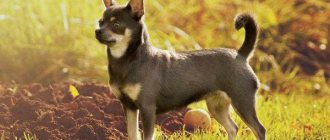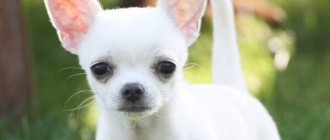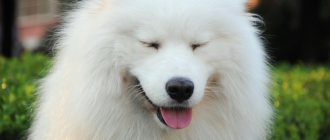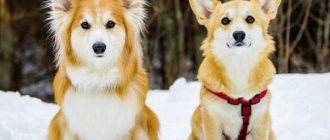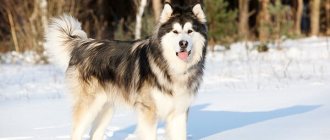Nowadays, it is not so common to see Chihuahua Deer, as most breeders prefer to breed Cobby type dogs.
But these graceful dogs have their admirers, who remain faithful to the classic type of the breed.
At first glance, Chihuahua Deer may seem too tender and fragile. In fact, they are in no way inferior to their stronger and more powerful-looking cobby relatives.
In the article we will tell you in detail about this breed of Chihuahua, and also show photos of these dogs.
History of the breed
When Chihuahuas appeared, there was no single breed type. Dogs could be of any color and build, and there were also differences in their sizes.
But at the same time, high-legged dogs had advantages - it was easier for them to hunt small animals living in the jungles of Mesoamerica, where their ancestors appeared in the 15th century BC.
Perhaps it was this feature that helped the long-legged and fast dogs of this breed survive difficult times, when, after the conquest of Mexico by the conquistadors, they again went wild and lived in the forests. When they were domesticated again by local residents, these small, graceful dogs became faithful and devoted companions for them.
In the middle of the 19th century, American travelers became interested in Chihuahuas and local residents began selling them puppies of this breed.
Read more about the history of the Chihuahua here.
NOTE!
Most of the first Chihuahuas brought to the United States from Mexico were more similar to the modern Deer type of dog.
Long-legged, deer-like dogs were popular until relatively recently, when stocky Cobby-type Chihuahuas began to be considered more conformable.
Classification by size
The fashion for dividing breeds into categories based on the overall size of the dog came from foreign countries. In particular from America, where the term “tea cup” has long been established
).
In Russia, the following terms are used for classification:
The classification is carried out not so much by size as by body weight. In the first case, an adult dog corresponds to the weight recommended by cynological federations, i.e. weighs between 1.5 and 3 kg.
The last two miniature types of the Chihuahua breed do not have generally accepted boundaries, so each breeder interprets them to the best of his interests and knowledge. However, stick to the following weights:
- mini: from 1000 to 1500 grams;
- super-mini: from 500 to 1000 grams.
The FCI allows the weight of an adult Chihuahua dog to range between 500 and 1500 grams, but, as a rule, you should not expect high marks from judges at a breed show. In some cases, disqualification will follow, this also applies to the dir type.
To preliminarily determine the puppy's future weight as an adult, a special Chihuahua weight table has been developed. Of course, neither the table nor the seller guarantees the stated indicators.
Why you should not buy mini and super-mini Chihuahuas is described in detail in this article. Read on to avoid common mistakes made by novice breeders and hobbyists.
Description of character
The Chihuahua Deer is a small, elegantly built dog. She looks elegant and sophisticated, and her movements are light and free. When such a dog runs, it seems that it almost does not touch the ground.
Chihuahua Deer are smart and very understanding. These are active and playful dogs that, despite their apparent fragility, are resilient and quite strong.
They are selflessly devoted to their owner, friendly and affectionate towards him. But they are wary of strangers.
Chihuahua Deer make good guards. Despite their small size, they are always ready to protect their owner or his property.
Distinctive features
Distinctive features of dogs of this type are:
- the head is relatively small in size, slightly elongated in shape;
- elongated muzzle;
- large and high-set ears;
- deep, but not wide chest;
- rather long paws;
- long and thin tail;
- the angles of the articulations are less pronounced than those of the cobby;
- There is no sense of strength or power in the movements of Deer type dogs.
Deer-type Chihuahuas do not have well-developed muscles, which makes them visually more sophisticated than representatives of the Cobby type.
Intrabreed branches
There are Russian breeders who have developed the existing classification and identified a number of subtypes:
- Pekingese Excessively snub-nosed and bug-eyed dogs, reminiscent of Japanese Chins, but not Pekingese. These are individuals with significant shortcomings, almost defects, undesirable guests at exhibitions and not suitable for further breeding;
- Aboriginal Often such dogs are brought from their historical homeland, from Mexico. However, they categorically do not correspond to the modern standard: their height is at the limit of the upper limit, the head is simplified, narrowed, and not round enough. The ears are set high and too close to each other, the eyes are also set close together;
- English In fact, it absolutely does not correspond to the achievements of English breeders; “English” refers to animals of a rough constitution, with an overloaded skeleton;
- Extreme As a rule, dwarf dogs with a bulging forehead and bulging eyes. The “extreme sports” have a snuffy muzzle, their movements are terrible, since their extremely short legs are not designed for walking or running;
- Exotic The same extreme, but even smaller, the so-called “dog in a cup” type;
- A classic variation of the “dirov”, but the head is simplified, the transition from the forehead to the muzzle is smoothed, the muzzle is lowered.
Animals belonging to any of the “subtypes” are a breeding defect, a nursery error. But since there are plenty of people who want to get an inexpensive but fashionable dog, the demand for such unfortunate Chihuahuas does not weaken.
Accepted standard type dir
The size of a standard Chihuahua Deer should be no more than 23 cm at the withers. Weight ranges from 0.5 to 3 kg.
The Chihuahua Deer is a small, square dog with a light bone structure.
The head does not look large or convex. The transition to an elongated muzzle is pronounced, but not sharp.
The ears are large and rather thin. They are set high, which gives the dog a resemblance to a fawn.
The eyes are relatively small, slightly convex. Their most preferred color is dark shades of brown.
The nose color is black or matches the base color.
The neck is quite long and narrow. The back is straight, not wide, merging into a slightly sloping croup.
The chest is deep enough, but not too voluminous. The stomach is tucked.
The limbs are parallel, due to the lack of pronounced muscles, they appear thin and long.
The tail is set quite high, long and thin.
The coat is soft, can be either smooth or quite long, but not fluttering.
According to the breed standard , all colors except merle are considered acceptable for Chihuahuas.
Expert opinion
Kozhevin Semyon Kirillovich
Expert dog handler.
Deer-type dogs are on the verge of the standard. Many Deer Chihuahuas look more like small greyhounds than their own breed. This dog is a representative of the classic breed type, which has existed for centuries and was incredibly popular back in the first half of the twentieth century. However, the exterior of such dogs should not have the excessive lightness of build and stylization inherent in many modern Chihuahua Dires.
Other types
If we talk about various disruptions in the development of these dogs, then there are also two types that allow us to classify Chihuahuas one way or another. The two big types are shortcomings and vices.
Flaws
These are various external defects that can prevent your pet from being recognized at a show, and can also cause health problems in the future.
Disadvantages, as a rule, include various deformations of the jaw, the absence of some teeth (or, conversely, the presence of extra ones), overly pointed ears, too long a body, shortened paws, turned out elbows or a tail of the wrong size or shape.
Vices
This is more serious. If in the last paragraph we talked only about physiology, then here the matter also concerns mental disorders, which promises much bigger problems in the future. They are also the reasons for the disqualification of Chihuahuas from various exhibitions.
Defects are considered to be atypical behavior (excessive cowardice or aggressiveness), floppy ears, lack of a tail, bald spots, large fontanel or excess weight (more than 3 kg).
How is it different from a cobby?
The Deer differs from the Cobby-type Chihuahua in its greater grace and lightness of structure.
The head of the dir is less voluminous, and the muzzle is longer.
The position of the ears is also different - in the cobby they are low and relatively small in size, while in the dir the ears are large, thin and high-set.
Head shape options
The largest canine organizations recognize the only type of head in the Chihuahua, which forms the shape of an apple. The forehead is large, convex, the stop is deep and pronounced. The muzzle is short.
For a long time, the main distinguishing feature of the breed was considered to be an open fontanel located in the parietal region of the rounded skull. In the latest editions of the standard, molera was equated to disqualifying defects.
The narrow shape of the skull with an elongated muzzle is called “deer head”. The belief that the deer head is found only in Deer-type Chihuahuas is a misconception. But 90% of cases are true. As a rule, it is found among mestizos.
Advantages and disadvantages
Pros:
- look sophisticated and elegant;
- sociable and playful;
- are distinguished by loyalty and love for their owners;
- They make sensitive watchmen;
- do not need a large living space;
- if you accustom your Chihuahua Dir to a tray or diaper, then you can forget about walks in inclement or too cold weather;
- do not require complex and time-consuming care;
- You can take such a dog with you on any trip;
- smart and trainable.
Minuses:
- You cannot buy such dogs for families with children;
- may be injured during a jump or fall;
- if not properly raised, they can show aggression even towards their owner;
- monogamous - they recognize only one owner in the family;
- can bully other people's dogs on the street;
- sometimes they are quite jealous;
- They don't like dogs of other breeds.
IMPORTANT!
When training a Chihuahua Dire, it is necessary to take into account that physical methods of influence cannot be used during training.
Differences in Temperament
Chihuahuas have an extremely stable psyche, which reaches its development within a year. It is difficult to find cowards and hysterics among them, although of course there are exceptions - as many dogs as there are, so many peculiarities. For the owner, this dog will become a wonderful companion and a faithful, sometimes jealous friend. But some representatives of the breed, depending on the different type of coat, may have different behavioral characteristics.
It is believed that dogs with a long coat type have a soft and flexible character and a calmer temperament. Whereas Chihuahuas with short hair are often quick-tempered and live a more active life.
Basic rules of care
The coat of a smooth-haired dog should be combed with a brush two or three times a week, and during the shedding period - daily. It is recommended that long-haired Deer Chihuahuas be combed with a comb every day.
It is not necessary to bathe these dogs often, and it is better not to wash them at all unless necessary.
Your pet's ears and eyes should be examined every day in order to notice the first signs of inflammation in time. They only need to be cleaned if they become dirty. Nails should be trimmed with a nail clipper once every six months.
To clean teeth, your pet should be given chewing toys or treats designed to remove plaque.
Due to the fact that the deer has an accelerated metabolism, these dogs need warm clothes even in cool weather, and the pet must wear them indoors.
NOTE!
Chihuahua Dire is not intended for street keeping - such a dog should only live in a house or apartment.
How to choose a puppy?
Despite the fact that most modern breeders breed Cobby Chihuahuas, it is still quite possible to find Dire puppies with documents.
When choosing a future pet, you need to pay attention to the structure of its muzzle and head - while cobbies have a convex skull, dirs have an elongated one. The muzzles of this type of Chihuahua are quite long, the ears are larger and set high, and the eyes are not very large and less rounded than those of the Cobby, and this is noticeable already at an early age.
IMPORTANT!
The Chihuahua puppy should have a balanced psyche and should not have even the slightest signs of illness.
What dog experts say
We have described the standard types and types into which Chihuahua dogs can be divided. In addition, there are many nuances that will help you not make a mistake in choosing a pet and buy exactly the dog that you originally wanted.
Firstly, it is worth considering the fact that there are a lot of unscrupulous breeders. There are breeds that are not recognized by the standard, but they are often passed off as the standard type of Chihuahua. These, for example, include the Pekingese, Aboriginal, English, Extreme, and Exotic types. All these breeds are not recognized by the standard and are considered defective. And it’s not surprising, because many of the above breeds could have been bred only to see what would happen if the dog had non-standard proportions.
Similar article: Who is better and which one to choose: Chihuahua or Toy Terrier
For example, an extreme type Chihuahua has really extremely short legs, on which it cannot even walk properly. Thus, all these types are not included in the standard, and life is very difficult for animals of such breeds. Of course, you can buy such a dog, but it will require special care, and you definitely won’t be able to send it to an exhibition.
Secondly, if you want to buy a pet to participate in exhibitions, it is recommended to choose a cobby type. Although, according to dog experts, this type is rarely seen in its pure form now, so if you want to assess the prospects, look at the baby’s parents and evaluate their successes at exhibitions.
The last thing worth saying is that you should not opt for a low price. Of course, it is not a fact that if you buy a dog for a lot of money, this acquisition will be successful, but the likelihood of becoming the owner of a sick puppy by purchasing it for a low price is extremely high. Therefore, carefully check from whom and for what amount you will purchase a pet. And if you decide to buy a dog with health problems, make sure you know exactly what’s wrong with it and how it can be cured (and whether it can be).

